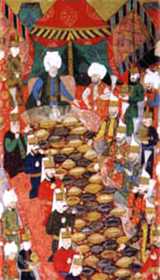During your walks through the streets of Istanbul you will often come across some shops ‘windows beautifully displaying appealing golden pieces of baklava decorated with pistachio. This distinguished kind of sweets attracts your sight with its golden polish; it will awaken all your senses with its delicious smell of sugar and butter and with its crunchy sweet taste. Baklava isn’t just a popular desert in Turkey; it is also quite famous in the Near East, in Balkans and Caucasus. Different countries claim baklava as their own national food.

However, while investigating the history of the baklava, it is quite challenging to trace back its exact origins, mainly due to the lack of reliable historical evidence and sources. It is undeniable that baklava is the product of the fusion of several previous cultures and nations who lived in the dynamic atmosphere of Anatolia, Balkans and the Near East during the middle Ages. During the Ottoman state, the first encounter with of Baklava was in the findings of some kitchen notes documented during the reign of Mehmed II. Throughout history, the Topkapı Palace became one of the main producers of baklava in which it has evolved to its current form. Moreover, these traditional sweets once made up an important part of the state’s protocol which is visible in the example of the “Baklava Alayı” which was introduced during the reign of Sultan Suleiman the Magnificent. On the 15th day of Ramadan the janissaries marched to the palace in order to take the baklava made for them in the palace’s kitchen by the order of the sultan.With the backing trays carried in their hands, soldiers marched under the sight of the crowds back to their barracks. This ceremony became over time a traditional custom and a repetitive entertainment for the population of Istanbul.
At first baklava was the food of the elite but it gradually reached larger social classes with the opening of small shops for selling baklava in the late 19th century, leaving a significant impact on the lives of common people ever since. Today these sweets occupy an irreplaceable cultural significance in momentous events like birth, marriage or religious feasts. In Ramazan (Feast of Breaking the Fast) and Kurban (Feast of the Sacrifice) Bayramı the guests are often offered home-made baklava accompanied with a cup of black tea.
 One of the extant traditions about baklava is seen in Aegean part of Turkey specifically first morning of Ramazan Bayramı. According to Turkish customs, close relatives from the bride side such as bride’s mother or aunt roll out dough for baklava and first piece placed in the middle of the round metal tray is eaten by son-in-law among newly-wed-couples. Until he takes the first bite, no one is allowed to eat from the tray before he does therefore, new couple wakes up early to visit their families in their first Bayram morning as a married couple.
One of the extant traditions about baklava is seen in Aegean part of Turkey specifically first morning of Ramazan Bayramı. According to Turkish customs, close relatives from the bride side such as bride’s mother or aunt roll out dough for baklava and first piece placed in the middle of the round metal tray is eaten by son-in-law among newly-wed-couples. Until he takes the first bite, no one is allowed to eat from the tray before he does therefore, new couple wakes up early to visit their families in their first Bayram morning as a married couple.
The preparation of baklava is difficult and time consuming. Firstly the baklava master rolls out numerous wafer thin layers of filo separated in the middle by a layer of nuts. The most favored sort of nuts is pistachio which grows in the Southeast of Turkey especially in Gaziantep internationally known for both the Antep Fıstığı (pistachio) and Antep Baklavası. After cutting the filo in rectangles or diamonds the master dashes over melted butter. The final step after backing is pouring şerbet over the baklava, which is made of boiled water, sugar and lemon juice. On the basis of filo, nuts and şerbet there are numerous variations of baklava like Sütlü Nuriye, Şöbiyet or Dilber Dudağı.
 In order to balance out the sweetness, few rectangle pieces are most of the time served with black tea or simply with water it could also be served with kaymak (clotted cream) or ice cream. For establishing a contrast and highlighting the taste it can be served with sugarless Turkish coffee or more seldom with ayran, a beverage made of water and yogurt.
In order to balance out the sweetness, few rectangle pieces are most of the time served with black tea or simply with water it could also be served with kaymak (clotted cream) or ice cream. For establishing a contrast and highlighting the taste it can be served with sugarless Turkish coffee or more seldom with ayran, a beverage made of water and yogurt.
In order to reach the perfect balanced taste, baklava masters recommend turning the baklava’s bottom up and press the bottom side of it against the roof of the mouth in order to taste the butter and şerbet concentrated on the bottom of the pieces.
To conclude the best place to eat delicious baklava is Karaköy Güllüoğlu in Istanbul. Founded in 1820 and continued as a family business, it is a place well-known not only by the locals of Istanbul but also by tourists for its fine quality. Although always crowded, it offers several variations of baklava and a tasting experience for people who eat their first pieces. If you’re a fan of sweets you won’t be disappointed.
